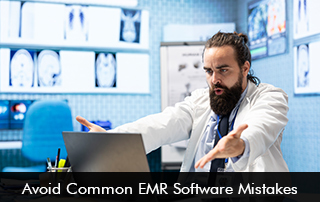Electronic Medical Record (EMR) Software has changed healthcare for the better by making documentation faster and easier, helping different healthcare providers work together more smoothly, and ultimately leading to better patient results. Even so, many providers still run into problems when using these systems, and a lot of the time, it’s because of mistakes that could have been prevented. If practices can figure out these common slip-ups and fix them, they can make using EMR Software a much better experience overall.
Common EHR Software Mistakes
Not Enough Training When Starting Out
A common problem with EMR software is that users just don’t get enough training on it. When new staff members aren’t properly introduced to the electronic health records software system, they can have a hard time figuring it out. This can cause mistakes, frustration, and really mess up the whole workflow. Giving everyone thorough training that’s specific to their job is key. It makes users feel more confident and helps them work more accurately and efficiently.
One-Size-Fits-All Approach Doesn’t Work
Many medical practices use standard EHR Software templates without adjusting them to fit their specific needs. This creates messy screens with a bunch of fields that don’t even apply. Taking the time to customize templates and dashboards so they match what each provider needs makes entering data much faster and improves the quality of decisions being made.
Ignoring Software Updates
Think of software updates like tune-ups for the EMR system. EHR Software companies regularly roll out these updates to boost security, add new features, and squash those pesky bugs. If practices skip these updates, they are leaving the system’s doors wide open to potential security breaches and things might not work as smoothly. Staying on top of updates ensures everything runs like a well-oiled machine and keeps your data safe and sound.
Lack of Integration with Other Systems
Imagine systems working in isolation, like separate islands with no bridges connecting them. This can lead to data getting stuck in one place and people having to do the same work twice. When the EMR Software doesn’t talk to the billing, lab, or pharmacy systems, things aren’t as efficient as they could be. But when you integrate everything, it’s like building those bridges, allowing data to flow freely and making everyone’s life a whole lot easier by reducing paperwork and manual tasks.
How Avoiding EMR Software Mistakes Can Improve User Experience.
By steering clear of typical EHR Software missteps, the user experience gets a direct upgrade, making tasks simpler, cutting down on slip-ups, and preserving valuable time. An EMR system that’s set up right and kept current, and that works seamlessly across different departments, leads to more streamlined processes. When users get the training they need and their opinions are taken seriously, they’re more inclined to embrace the system and use it to its full potential.
In the end, a better EMR user experience means happier providers, less burnout, and a higher standard of patient care. Healthcare organizations that put effort into the proper use of Electronic Medical Records Software are more adaptable, operate more efficiently, and are better prepared to tackle the challenges of modern healthcare.








